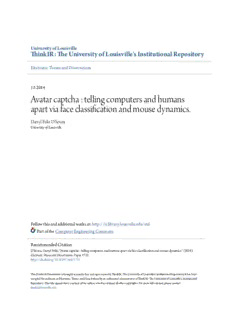
Avatar captcha : telling computers and humans apart via face classification and mouse dynamics. PDF
Preview Avatar captcha : telling computers and humans apart via face classification and mouse dynamics.
UUnniivveerrssiittyy ooff LLoouuiissvviillllee TThhiinnkkIIRR:: TThhee UUnniivveerrssiittyy ooff LLoouuiissvviillllee''ss IInnssttiittuuttiioonnaall RReeppoossiittoorryy Electronic Theses and Dissertations 12-2014 AAvvaattaarr ccaappttcchhaa :: tteelllliinngg ccoommppuutteerrss aanndd hhuummaannss aappaarrtt vviiaa ffaaccee ccllaassssiifificcaattiioonn aanndd mmoouussee ddyynnaammiiccss.. Darryl Felix D’Souza University of Louisville Follow this and additional works at: https://ir.library.louisville.edu/etd Part of the Computer Engineering Commons RReeccoommmmeennddeedd CCiittaattiioonn D’Souza, Darryl Felix, "Avatar captcha : telling computers and humans apart via face classification and mouse dynamics." (2014). Electronic Theses and Dissertations. Paper 1715. https://doi.org/10.18297/etd/1715 This Doctoral Dissertation is brought to you for free and open access by ThinkIR: The University of Louisville's Institutional Repository. It has been accepted for inclusion in Electronic Theses and Dissertations by an authorized administrator of ThinkIR: The University of Louisville's Institutional Repository. This title appears here courtesy of the author, who has retained all other copyrights. For more information, please contact [email protected]. AVATAR CAPTCHA: TELLING COMPUTERS AND HUMANS APART VIA FACE CLASSIFICATION AND MOUSE DYNAMICS By DarrylFelixD’Souza M.S.inComputerScience,UniversityofLouisville,USA,2009 B.Eng. inComputerEngineering,UniversityofMumbai,India,2006 ADissertation SubmittedtotheFacultyofthe J.B.SpeedSchoolofEngineeringoftheUniversityofLouisville inPartialFulfillmentoftheRequirements fortheDegreeof DoctorofPhilosophy DepartmentofComputerEngineeringandComputerScience UniversityofLouisville Louisville,Kentucky December2014 Copyright©2014byDarrylFelixD’Souza Allrightsreserved AVATARCAPTCHA:TELLINGCOMPUTERSANDHUMANSAPARTVIAFACE CLASSIFICATIONANDMOUSEDYNAMICS By DarrylFelixD’Souza M.S.inComputerScience,UniversityofLouisville,USA,2009 B.Eng. inComputerEngineering,UniversityofMumbai,India,2006 ADissertationApproved onOctober13th,2014 bythefollowingDissertationCommittee: Dr. RomanV.Yampolskiy,CECSDepartment, DissertationDirector Dr. Dar-jenChang,CECSDepartment Dr. IbrahimImam,CECSDepartment Dr. CharlesTimothyHardin, IndustrialEngineeringDepartment ii DEDICATION ThisdissertationisdedicatedtomydearparentsFelixandPhilomena,mylategrandpa Joseph,mygrandmaLily,mydearfamilymembersandfriendswhohavebeenmymoral supportthroughtheirincessantloveandpatience. IowethisonetoyouallasIcouldnever achievethispinnacleinmycareerwithoutyourblessingsandfriendship. iii ACKNOWLEDGMENT ThecompletionandwritingofmyPh.D.dissertationhasbeenalongandwonderfuljour- ney. Ithasbeenoneofthemostsignificantacademicchallengeswithanimmenselyrewarding experience and a learning curve that has taught me the l of research. Without the support, patienceandguidanceofthefollowingpeopleIwouldnothaveachievedthismilestone. Iowe themmydeepestgratitude. WithgreatpleasureandgratitudeIthankmymentorDr. RomanV.Yampolskiywhohas been inspirational and motivating through his wisdom, knowledge and commitment. He has beenagreatsourceofguidancecomplementedwithadowntoearthattitudeandaninnovative researchvision. My committee members, who have bestowed upon me the knowledge through their courses that have been extremely helpful and instrumental not only in completing this dis- sertationbutalsoinmyacademiccareer. My friend and colleague, Jacob Matchuny who deserves a special vote of thanks for as- sistingmeinthisworkwithpatience,interestandenthusiasm. The volunteer subjects and online human users who contributed their invaluable time andfeedbacktowardssolvingtheCAPTCHAchallengesandhelpingmegainsomeresourceful insightsintomyworkaswellasvalidateit. My lab colleagues Abdallah Mohamed, Nawaf Ali, Marc Beck and Roger Ouch together withmydepartmentcolleaguesandfriendsforhelpingmeduringdifferentphasesofmywork. Theyhavesupportedandmotivatedmeasfellowpeers. Wehaveallbeenaclose-knit,diverse groupthatenjoyedresearch,travel,sportsandfood. The two-year Grosscurth fellowship and the Department of Computer Engineering and ComputerSciencefortwoandahalfadditionalyearsoffinancialsupportthataidedthepursuit ofmyPh.D. iv FelixandPhilomena,mydearparents,Delna,mysisterandmyfamilymemberswithout whom this effort would have amounted to nothing. Your unconditional love, support, prayers andprofoundunderstandinghavebeeninspirationalandencouragingsupplementstofuelmy motivationtohelpmeachievethisgoal. v ABSTRACT AVATAR CAPTCHA: TELLING COMPUTERS AND HUMANS APART VIA FACE CLASSIFICATION AND MOUSE DYNAMICS DarrylFelixD’Souza October13th,2014 Bots are malicious, automated computer programs that execute malicious scripts and predefined functions on an affected computer. They pose cybersecurity threats and are one of the most sophisticated and common types of cybercrime tools today. They spread viruses, generatespam,stealpersonalsensitiveinformation,rigonlinepollsandcommitothertypesof onlinecrimeandfraud. TheysneakintounprotectedsystemsthroughtheInternetbyseeking vulnerable entry points. They access the system’s resources like a human user does. Now the question arises how do we counter this? How do we prevent bots and on the other hand allowhumanuserstoaccessthesystemresources? OnesolutionisbydesigningaCAPTCHA (CompletelyAutomatedPublicTuringTeststotellComputersandHumansApart),aprogram thatcangenerateandgradeteststhatmosthumanscanpassbutcomputerscannot. Itisused as a tool to distinguish humans from malicious bots. They are a class of Human Interactive Proofs(HIPs)meanttobeeasilysolvablebyhumansandeconomicallyinfeasibleforcomputers. Text CAPTCHAs are very popular and commonly used. For each challenge, they generate a sequenceofalphabetsbydistortingstandardfonts,requestinguserstoidentifythemandtype them out. However, they are vulnerable to character segmentation attacks by bots, English languagedependentandareincreasinglybecomingtoocomplexforpeopletosolve. Asolution to this is to design Image CAPTCHAs that use images instead of text and require users to vi identify certain images to solve the challenges. They are user-friendly and convenient for humanusersandamuchmorechallengingproblemforbotstosolve. Intoday’sInternetworldtheroleofuserprofilingoruseridentificationhasgainedalotof significance. Identitythefts,etc. canbepreventedbyprovidingauthorizedaccesstoresources. Toachievetimelyresponsetoasecuritybreachfrequentuserverificationisneeded. However, this process must be passive, transparent and non-obtrusive. In order for such a system to be practical it must be accurate, efficient and difficult to forge. Behavioral biometric systems are usually less prominent however, they provide numerous and significant advantages over traditional biometric systems. Collection of behavior data is non-obtrusive and cost-effective as it requires no special hardware. While these systems are not unique enough to provide reliable human identification, they have shown to be highly accurate in identity verification. In accomplishing everyday tasks, human beings use different styles, strategies, apply unique skillsandknowledge,etc. Thesedefinethebehavioraltraitsoftheuser. Behavioralbiometrics attempts to quantify these traits to profile users and establish their identity. Human com- puterinteraction(HCI)-basedbiometricscompriseofinteractionstrategiesandstylesbetween ahumanandacomputer. Theseuniqueusertraitsarequantifiedtobuildprofilesforidentifi- cation. A specific category of HCI-based biometrics is based on recording human interactions with mouse as the input device and is known as Mouse Dynamics. By monitoring the mouse usage activities produced by a user during interaction with the GUI, a unique profile can be created for that user that can help identify him/her. Mouse-based verification approaches do notrecordsensitiveusercredentialslikeusernamesandpasswords. Thus,theyavoidprivacy issues. An image CAPTCHA is proposed that incorporates Mouse Dynamics to help fortify it. ItdisplaysrandomimagesobtainedfromYahoo’sFlickr. Tosolvethechallengetheusermust identifyandselectacertainclassofimages. Twotheme-basedchallengeshavebeendesigned. TheyareAvatarCAPTCHAandZooCAPTCHA.Theformerdisplayshumanandavatarfaces whereas the latter displays different animal species. In addition to the dynamically selected images,whileattemptingtosolvetheCAPTCHA,thewayeachuserinteractswiththemouse i.e. mouse clicks, mouse movements, mouse cursor screen co-ordinates, etc. are recorded non- obtrusivelyatregulartimeintervals. TheserecordedmousemovementsconstitutetheMouse Dynamics Signature (MDS) of the user. This MDS provides an additional secure technique to segregatehumansfrombots. ThesecurityoftheCAPTCHAistestedbyanadversaryexecuting amousebotattemptingtosolvetheCAPTCHAchallenges. vii
Description: